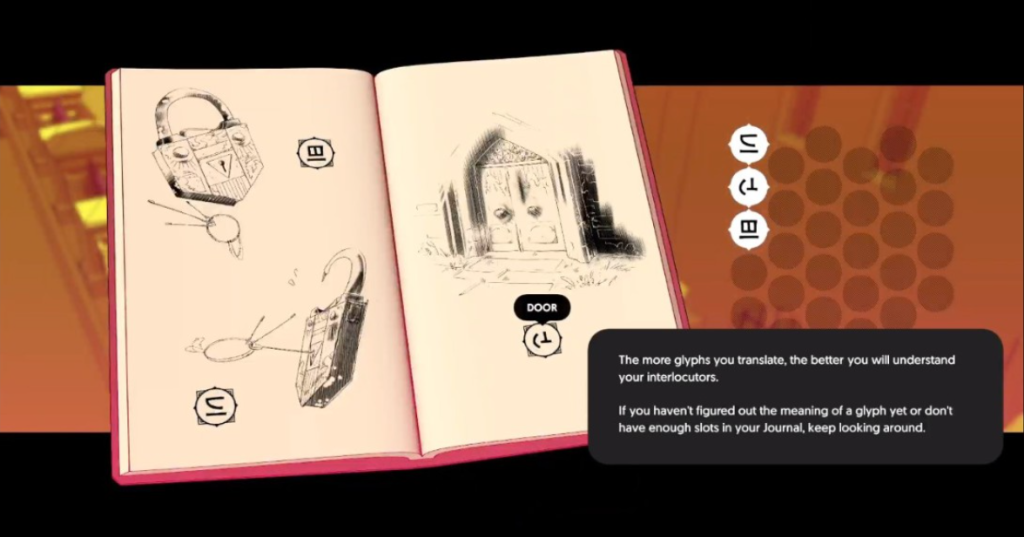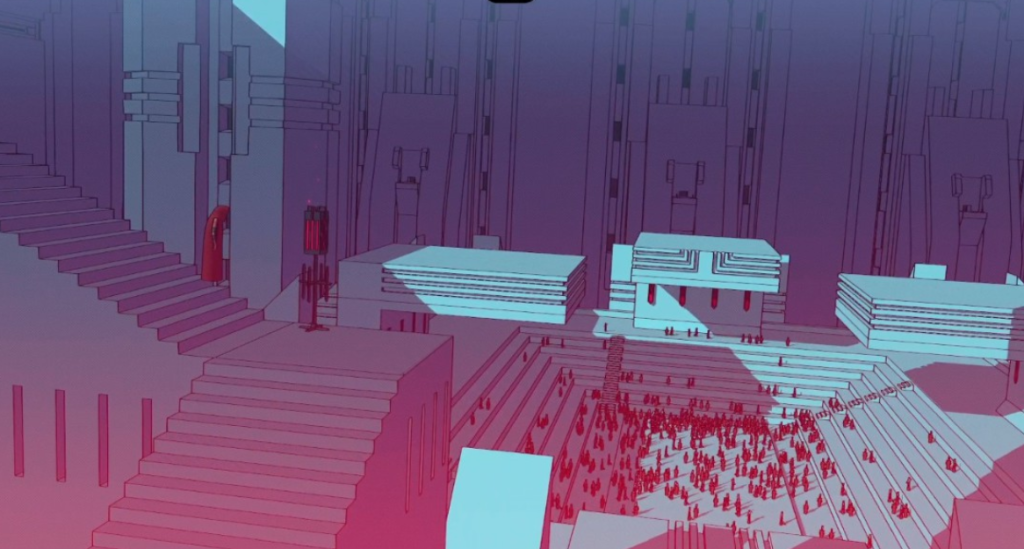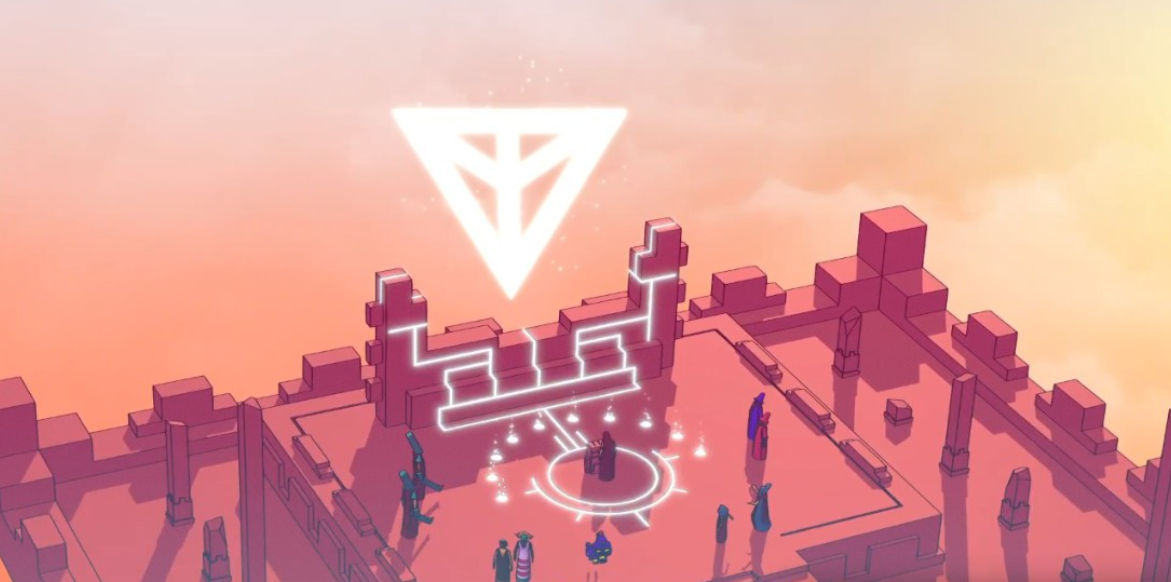During one of my many breaks from Grounded, I started and finished Chants of Sennaar. A coworker recommended it not too long before it hit Game Pass, so it was perfect timing. The concept of trying to unravel the mysteries of the game via translating the languages interested me.
Over the hours it took to complete the game, I was in awe at the feeling of discovery after guessing and confirming simple words. There were some minor annoyances with puzzles I overlooked the pieces to complete, but those were few and far between.
Figuring Out Translations Like Indiana Jones

Right from the start, Chants of Sennaar is unlike any other game I’ve played. The main draw of the game is translating the various languages of the tower to solve puzzles and reach the next level up. There are plenty of puzzles to test inference skills.
Sometimes there are illustrations on the wall with hieroglyphs to associate with the items or actions shown. Other times there are residents of the tower that try to chat with you to complete tasks. Their body language and motions help provide clues for the hieroglyphs meanings.
Once I had an idea of what a glyph meant, I could write words to represent it or provide context for it. After that, my words show up next to those glyphs when reading or chatting. Farther along in the story, pages in the journal unlock to match up hieroglyphs to nouns and verbs.
When the matches are all correct, the game locks them in and verifies they are correct. The glyphs then show those words and help fill in the gaps to help discern the other unknowns in a sentence. It’s a very satisfying game loop to act like Indiana Jones deciphering an old language to find the treasure.
Adding Complexity to Translations
There are a few times where I missed a semi obvious door or a partial Rosetta-like stone. Lacking those to progress, I’d get a bit annoyed. The satisfaction of slowly unraveling the languages did far out way the minor annoyances I’d run into with some puzzles.
As I reached higher levels, Chants of Sennaar added further complexity with differing sentence structures. For some languages, for example, the plural of something was as simple as placing two of the same glyphs next to each other. Other languages, however, had a specific symbol to identify a plural.
Each group in the tower also had different names for the other groups in the tower. That was tricky for a very short time, but the differences in sentence structure became worse. The varying languages used different orders for nouns, verbs and adjectives.
One language my say “the soldiers go to the tower”, while another language may instead say “to the tower, the soldiers go”. That added layer pushed my buttons a few times, but was worth the satisfaction of figuring out how that groups structures their sentences.
Later on in the game, my task moved onto translating phone calls between the different groups in the tower. I served as a translator to help bring all of the people of the tower together. The differences between how each treats plurals and the ordering of their sentences ratcheted up the difficulty.
The ultimate purpose of the cross language translations was to help people and it was addicting.
Chants of Sennaar Story

The ultimate story of the Chants of Sennaar revolves around helping people to come together. Within the tower, there were five difference levels with different types of people on each level. Each of them had their own language and often feared each other.
It reminds me a lot of the Tower of Babel, at least with my passing knowledge of it. I unraveled each language to progress to the next level of the tower. The most important part of my journey was not just to reach the top, but to bring people together through my translation of their languages.
Their fear of each other turned to curiosity and community after they could understand each other. There were worshippers, soldiers, artists, scientists and exiles at each new level of the tower. It was a nice change of pace from the robes and more religious centered beginnings.
The game has much different names for each of those groups at each level that I don’t want to spoil with their real names. It was actually fun that I guessed the wrong name for each group, but the gist of my guess was close enough that it gave my journal entries more meaning.
Running into the artists was very interesting, but the scientists were my favorite. Their lab experiments threw me back to my days in the lab for my Physics degree. Helping them perfect their formula was definitely one of the highlights of the game.
The exiles at the last level, though, were a real nice twist in the game. I definitely don’t want to spoil anything with them since it’s a nice nod to future PC gaming. It’s also the shortest level thanks to their translation machines that speed up the process.
Making a Difference in Chants of Sennaar
As I traveled back and forth to the different levels of the tower (thankfully there’s teleportation-like devices), it was great to see how my aid in bringing people together changed things. Soldiers enjoyed performance from the artists, for example, and they went onto help scientists catch a monster.
By the end of my journey, I saw both the “bad” and “good endings”. The bad ending is lonely and fitting because I failed to bring everyone together. I reached the top of the tower, but there was no way to save the tower without the help of all the people.
Fast forward to the “good” ending, I spent the extra hours to bring all the people of the tower together. I survived a great twist with the exiles alternate reality to reach the finish line. Seeing the good ending after the extra effort was very satisfying and worth the extra effort.
Chants of Sennaar is one of those rare indie games where the meaning will stick me for a long time. Games like this are one of the super powers of Game Pass. Very little risk to try a fantastic game like this. I highly recommend it to any puzzle fan or aspiring linguists.
